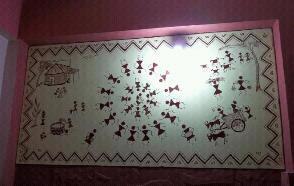Uploading some more information about Warli Painting....
Warlis are found in Javhar, Dahanu and Talasari talukas of the northern Thane district, parts of Nashik and Dhule districts of Maharashtra, Valsad, Dangs, Navsari and Surat districts of Gujarat, and the union territories of Dadra and Nagar Haveli and Daman and Diu.
Their oral tradition tells us that the Warlis moved southwards in search of lands for shifting cultivation to the foothills of the Sahyadr (also known as the Western Ghats), where they live now. With a view to putting an end to what they considered the wasteful practice of shifting cultivation, the British evicted Warli villages deep into the forests, and resettled them on the fringes. history and religion= Warli is the name of a tribe, which resides in Thane district of Maharashtra on the northern outskirts of Mumbai and extends up to the Gujarat border. They are spread out in the villages named Dahanu, Talasari, Mokhada, Vada, Palghara and several other parts of the district as well. The origin of the warlis is yet unknown and no records of this art are found, but many scholars and folklorists believe that it can be traced to as early as tenth century A.D when man learnt to build walls of the house. This art was eventually discovered in the early seventies, and became popular for its unique simplicity and fervor for life. The warlis were originally hunters but today they are farmers and work according to the monsoon. Thus their paintings are also influenced by the seasonal cycle as their life around them is directly reflected in the paintings. Traditionally, only women practiced this art form on the interior walls of their mud houses. Since at that time rice was most easily accessible, they used the colour white, which was made from ground rice flour. As time passed by, the men have also begun to paint. To understand and enjoy the paintings of Warlis, one should know their religion, their rituals and see life from their perspective. As the life of warlis link closely with nature, they worship the nature in different forms – Sun and moon, God of thunder, lightning, wind, rain, and several others. Gods are worshiped according to the seasons. In the coming of the first rice they worship the god of rain and it’s called the festival of Naranadeva. This is then followed by the worship of household gods, in the festival of Hirva, Himai, Jhoting and Naranadeva. Next is the festival of Tiger God, and then is Kansari, the goddess of grain, and finally the marriage rituals take place, and this time the deity of fertility, Palghata, is worshipped. For the Warlis, life is cyclic repeating it eternally. Circles best represent the art of warli, which has neither an end nor a beginning. At all occasions – birth, marriage, and death they draw circles, symbol of Mother goddess. Death is not the end for them; rather it is a new beginning. Similar to their religious beliefs the warli paintings carry this circular and spiral movement that gives an everlasting joy....






